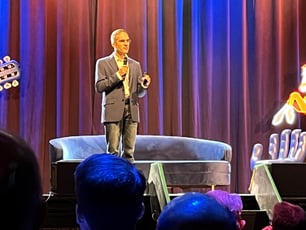The New Age In Construction
This article was written by Stewart Carroll, President of Beck Technology, and published April 2017 on Construction Today.
It’s 5 a.m. Monday, and Jeff Ratcliff, director of preconstruction, wakes up to a ringing phone. It’s Chad Schieber, the business development director at his construction firm, who received an email late last night from the client with the $100 million mixed-use project. Surprise: The budget review meeting planned for Wednesday has to happen this morning. Scrapping plans for breakfast with the kids, Jeff rushes through his morning routine and jumps into his car. His laptop is back at the office, and he’ll need it for the meeting at the client’s office.
Sprinting in and out of his office like Usain Bolt, Jeff grabs the laptop and gets to the meeting room where the client and Chad are waiting, only to realize that he left the projector behind. At his request, the receptionist rolls in a cart with a projector that looks like an industrial oven. Jeff only sees a VGA cable and asks for an HDMI adapter, and after a few minutes of the receptionist hunting through drawers, he’s finally connected and can start his presentation. The one-hour meeting is already halfway over.
The client starts asking questions, and all is well until he asks how his project compares to other projects of a similar size. Jeff left his historical cost spreadsheet on his office’s network drive, so he spends 10 more precious minutes trying to connect to the client’s Wi-Fi network and launch his VPN connection before the client says he’s out of time. Now, let’s replay this same scenario in a mobility-enabled world.
Jeff wakes up to the phone ringing with news of the meeting change but rolls over to catch a few more minutes of sleep before making the kids’ pancakes. Then, he showers, grabs his phone, and hits the road. At the office, coffee in hand, he sets his phone on its hands-free holder and kicks off a video conference, making sure that his phone’s camera has him in frame.
On his phone, Jeff brings up a web browser and logs into his corporate account on the web-based construction estimating platform, quickly navigating to the client’s estimate. The client and Chad appear on Jeff’s screen. They exchange pleasantries, and Jeff shares his screen. He brings up his web browser and walks the client through his budget and integrated takeoff, showing the project by area, and the corresponding costs by area. Along the way, Jeff shows critical project metrics, like the gross floor area, the project rentable area, the area of each floor, the floor-to-skin ratio, and how the metrics on this project compare to other similar projects.
The client is blown away by how quickly Jeff can react and how much data Jeff can provide in a one-hour meeting. He says he’s ready to move forward with the project and asks about next steps. There are a few things we can learn from this comparison—not only is mobility good for the blood pressure and kids who love their Dad’s pancakes, but it's also good for business.
From Wired to Wireless
Where once many construction jobs required the use of heavy hardware, phones, and other mobile devices can get the work done faster, cheaper and easier. The work can happen anywhere, from a meeting room to a job site to your kitchen table.
Yet, most of us working with clients in the field still rush around with a giant backpack full of clunky laptops, an assortment of cables and power supplies, a projector, paper and pens, and backup battery packs. If it’s not in that bag, we don’t have access to it, unless we can find a Wi-Fi connection and log into our office-based systems via a flaky VPN connection.
Let’s face it—our clients are not impressed. They, like all of us, live in a world where they can decide one minute that they want to buy a new pair of running shoes, and like magic, a pair will appear at their door the very next day. In an era of instant gratification, clients expect to get what they want, now.
Mobility solutions for the construction industry exist, but they haven’t yet been adopted for widespread, daily use. We’ve already got affordable, lightweight mobile devices that let us connect anytime from anywhere. We’re already having web meetings. And increasingly, the data we need to do our work is moving to the cloud, where it can be centrally located and accessible by any authorized user, anywhere.
What we need is for all of those things to come together, like they did for Jeff in that meeting that he conducted entirely on his phone. Most of the technology is there, so why isn’t it already happening?
Risk Aversion
In a traditionally slow-growth, low-profit-margin business like general contracting, there’s not much financial wiggle room for investing in new and unproven technology. GCs feel like they’re already flirting with risk every time they take on a job. Cloud data and mobility come with a learning curve, as well as security risks that must be managed. The old reliable hardware is a sure bet, and it’s paid for, so many companies will stick with it until it dies, long past the point when it becomes obsolete.
Cost
Jumping from wired to wireless is an expensive proposition, and the only way to do it is to do it all at once. That means everyone in the office gets a new device. Everyone gets a software license and training on the new, standardized platform. And you’ll have to start paying monthly or annual fees to centralize and secure all your data in the cloud. Put it all together and you’ve got a big, ongoing investment.
Fear of Change
Few things are more embarrassing than standing up to give a client presentation, then fumbling around with unfamiliar software on an unfamiliar device. Yes, lugging around a heavy laptop is painful, but at least it’s a pain you’re familiar with and can manage. No, you can’t get to the data you need on the fly, but that’s just how things have always been, right? When a $100 million job is on the line, the devil you know may look better than the devil you don’t.
Time
GCs are busy people who wear many hats. If they’re not on a project, they’re out chasing new work or jumping in to help a colleague. The forest might be on fire, but they don’t have time to worry about that because they’re putting out the fire that’s on their own desk. Learning a new way of working takes time, as do establishing new systems, populating them with data, and maintaining them over the long haul. Ironically, you have to invest time in new technologies to reap long-term time savings.
Change Is Coming, Like It or Not
Despite all of this innate resistance to change, the construction industry’s transition to a mobile-enabled workflow is inevitable. Except for the rare individual actively resisting technology, all of us live in a commercial world, interconnected with mobile phones and tablets. Even the least tech-savvy among us now have Wi-Fi in our homes. The world has been moving toward complete mobile connectivity for decades, and most of us understand that this is a good change that has many benefits for our daily lives.
Only by embracing the mobility learning curve can we achieve the same level of convenience and efficiency at work that we arrived at long ago in our personal transactions. Unprecedented connectivity has made our personal lives easier now than ever before, and our work lives can be too.
Old dogs can and will learn new tricks, and technology-savvy younger workers are eager to take the lead. To incoming millennials, life and work, and technology are intertwined. Software and mobile device developers are churning out new products with their preferences and lifestyle in mind. Your entry-level workers’ mobile mindset is the driving force that will take your construction business into the mobile age – ready or not.
So let go of the risk aversion and fear of change. Figure out how to invest the time and money. Because when you spend less time driving and setting up equipment, you can spend more time doing analysis, giving clients the information they want, and winning work—or just making pancakes for your kids.

-1.png?width=112&height=112&name=image%20(4)-1.png)














